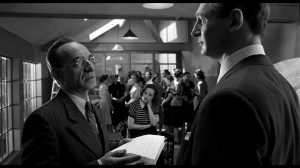Ten Lessons from Schindler’s List
Posted on December 8, 2013 at 8:00 am
 Steven Spielberg’s film about Oskar Schindler and the 1200 Jews he saved from being killed by the Nazis came out twenty years ago, based on the novel by Thomas Keneally (originally titled Schindler’s Ark)
Steven Spielberg’s film about Oskar Schindler and the 1200 Jews he saved from being killed by the Nazis came out twenty years ago, based on the novel by Thomas Keneally (originally titled Schindler’s Ark). Keneally happened on the story when he stopped in a Beverly Hills luggage shop and chatted with the owner, who turned out to be one of the people saved by Schindler. Keneally later wrote Searching for Schindler: A Memoir
, about his research, writing the book, and his dream of “an Oscar for Oskar” that came true when the movie was made in 1993.
The anniversary is just one of many good reasons to remember Schindler and ten of the lessons from the film.
1. Even if you cannot stop a great wrong, you can do something that will be very meaningful.
2. Heroes are not always exemplars of integrity and sacrifice. Oskar Schindler worked for the Nazis and was for much of his life an opportunist and self-promoter. Keneally once said that what interested him about Schindler was “the fact that you couldn’t say where opportunism ended and altruism began. And I like the subversive fact that the spirit breatheth where it will. That is, that good will emerged from the most unlikely places.” No one is perfect.
3. And a related lesson — sometimes a person’s faults are assets when it is time to rebel against authority.
4. Schindler was able to save 1200 people by insisting that they were essential employees in his business and contributing to Germany’s wartime efforts. This shows that people in business can — and must — make as much or an even greater contribution to the public good as government and non-profits.
5. The Nazi camp commander played by Ralph Feinnes shows us how a soul is destroyed by evil. The more corrupt he becomes, the more he must wall himself off from any sense of compassion or decency.
6. This movie was made half a century after the events it depicted and nearly 20 years after Schindler’s death. Sometimes it takes a while for us to be able to begin to understand historical events.
7. Some historical events are so enormous and so tragic they can never be fully understood. The best we can do is tell as many different pieces of the story as possible. The story of a small group who were saved must help us better understand the reality of those who did not survive.
8. As we reach the end of the time when living witnesses will be able to share their stories directly, it is even more important that we make sure that these stories are remembered. Making this film inspired director Steven Spielberg to create the Shoah Foundation and an archive of interviews.
9. Even a child can save a life with quick thinking and courage. 
10. To quote the line from the Talmud in ring given to Schindler by the Jews he saved: “Whoever saves one life saves the world entire.”

